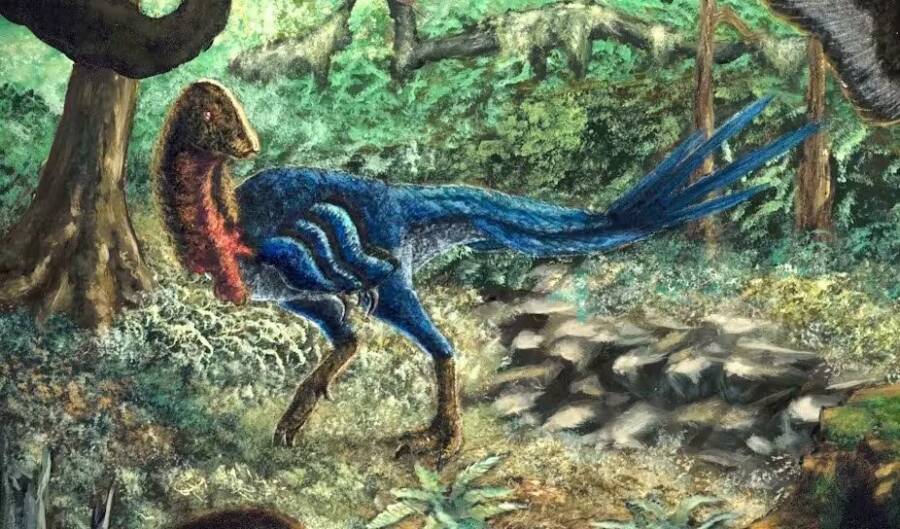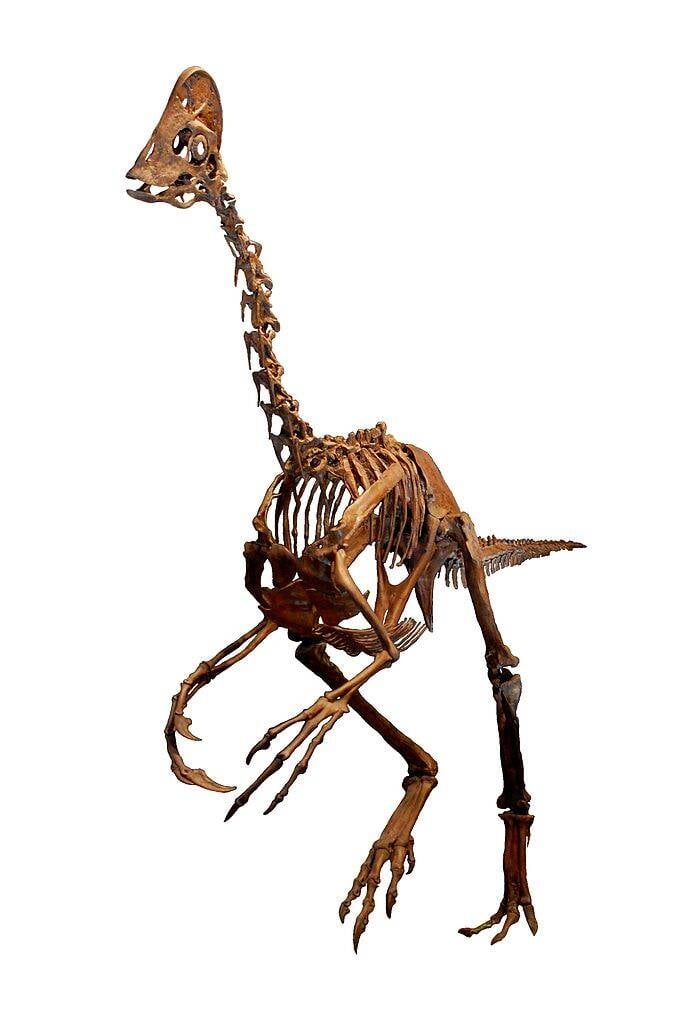Kyle Atkins-Weltman discovered a new dinosaur species, Eoneophron infernalis, while examining what he thought were Anzu wyliei fossils.

Zubin Erik DuttaA depiction of the new dinosaur species, Eoneophron infernalis.
While pursuing a masters degree at the University of Kansas, Kyle Atkins-Weltman set out to learn about a number of dinosaur species, including Anzu wyliei, a birdlike dinosaur known as the “Chicken From Hell.” Instead, his study of Anzu fossils led to the discovery of a previously unknown dinosaur: Eoneophron infernalis.
“It was really thrilling,” Atkins-Weltman said in a statement from Oklahoma State University, where he’s now working toward his PhD. “Based on the work and research I do, I never thought I would be someone to discover a new dinosaur species.”
Noticing Oddities In The Anzu Fossils
Atkins-Weltman’s incredible discovery came about in 2020, after he ordered a number of Anzu fossils from a collector. They had been found in the fossil-rich Hell Creek Formation, an area that contains parts of Montana, North Dakota, South Dakota, and Wyoming, and dated to the end of the Cretaceous period.
But as Atkins-Weltman took a close look at the bones, he noticed a few oddities.

Tadek Kurpaski/Wikimedia CommonsA reconstructed skeleton of Anzu wyliei, a dinosaur that is significantly larger than the new species.
For starters, the femur head seemed shorter than normal and was set at an odd angle. And the dinosaur’s ankle bones were fused to its tibia, a characteristic previously unseen in Anzu fossils. The bones were also much smaller, which initially led Atkins-Weltman to suspect they came from a young dinosaur.
“They were about 25 percent smaller than other Anzu fossils. We figured it was a juvenile Anzu,” he said, adding: “I assumed it was an Anzu until the evidence showed it wasn’t.”
As the Washington Post reports, Atkins-Weltman reached out to Oklahoma State University anatomy professor Holly Woodward for a second opinion. Woodward sliced open the bones and examined them under a microscope, where she discovered that the dinosaur was not a juvenile at all. Instead, its bones suggested that it had reached its peak growth.
In other words, it was a new species altogether.
“The discovery was exhilarating, shocking, and a bit anxiety-inducing,” Atkins-Weltman told All That’s Interesting. “Here I was, with this new species of dinosaur that effectively fell into my lap, and I had to make sure I had a thorough enough comparison and enough traits to set it apart from other members of its family.”
He continued: “The anxiety was induced by knowing that pressure was there. But that anxiety in a way was useful, because it ensured that I worked extra hard to be as thorough as possible.”
The Discovery Of Eoneophron Infernalis
Atkins-Weltman named the new species, which he just described for the first time in the journal PLOS One, Eoneophron infernalis. Its name translates to “Pharaoh’s dawn chicken from hell” and is an homage to Anzu as well as Atkins-Weltman’s late pet, a Nile monitor lizard named Pharaoh.

Kyle Atkins-WeltmanA sample of the dinosaur fossils that Atkins-Weltman studied. He originally thought they were Anzu wyliei bones, but they actually belonged to a totally unknown species.
Eoneophron probably stood about three feet high and weighed between 150 to 160 pounds. (Anzu, on the other hand, could weigh up to 660 pounds.) It was a bird-like dinosaur with feathers and wings, as well as a toothless beak and a short tail. Atkins-Weltman told All That’s Interesting that it lived alongside Anzu, as well as dinosaurs like Tyrannosaurus rex and Triceratops.
Interestingly, the discovery of the new species also challenges some previously held assumptions about dinosaurs. It’s long been believed that dinosaur species were already declining when an asteroid hit the Earth 66 million years ago, but the biodiversity of the Anzu and Eoneophron suggest that this family of species was thriving.
But questions about the new dinosaur still remain.
“We don’t have a skull so diet is hard to give any solid answer on,” Atkins-Weltman explained to All That’s Interesting, “though having a toothless beak means that even with a skull, it takes a lot more effort to infer diet than it would otherwise.”
He suspects that Eoneophron infernalis was probably “somewhere on the omnivore spectrum” and that its diet differed in some ways from Anzu.
Ultimately, Atkins-Weltman — whose research will take a “bigger picture” direction moving forward — has demonstrated through his discovery that scientific breakthroughs can sometimes happen slowly.
“It started out not with an eureka,” Atkins-Weltman noted, “but with a ‘Hmm, that’s odd.'”
After reading about the student who discovered a new dinosaur species, go inside the surprisingly complicated question of what killed the dinosaurs. Or, enjoy this collection of fascinating dinosaur facts.





